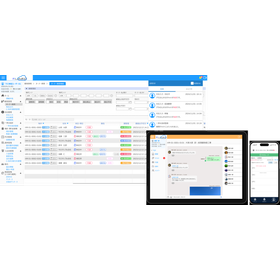A data platform for the manufacturing industry that systematizes the activity of 'monitoring production equipment without stopping' using 'the power of IT and people.'
Thank you for visiting the SUKKHA page! We believe that instead of a DX that ends at the stage of merely being "means" or "points," such as paperless initiatives, PLCs, and the installation of IoT systems, as well as the construction of core systems, we need a "purpose-oriented" and "line to surface" DX that utilizes accumulated equipment data to address daily problems. "Even the monitoring of manufacturing itself and the people involved contributes to inefficiency." "Isn't the root cause of inefficiencies and room for improvement found in the equipment?" "How can we improve machine rates? / How can we reduce unplanned downtime?" We look forward to discussing SUKKHA, which focuses on improving equipment performance, with everyone involved in the manufacturing industry!
Inquire About This Product
basic information
SUKKHA is a "data platform" that starts with equipment maintenance and contributes to expanding sales, reducing costs, and improving productivity in manufacturing sites. It can automatically suggest "how to communicate equipment abnormalities and what solutions to implement," and while it is software, it also offers custom solutions according to needs. <1_Visualizing all equipment conditions> It enables anyone, anywhere, to understand "which equipment is in what condition right now." This is expected to significantly reduce constant monitoring through visual inspection, downtime due to absence, and waiting for supervisors who are not on-site. <2_Utilization across a wide range of layers from the field to management> SUKKHA serves as a "hub of information" that contributes to solving the challenges of both management levels wanting to visualize "result improvements" and field levels wanting to visualize "daily operational processes." <3_Integration with other systems to achieve overwhelming productivity improvements> PLC, IoT sensors, core systems... SUKKHA connects systems used at "points" into "lines," creating a "plane." Furthermore, it defines and governs "how to collect and handle data," contributing to productivity improvements.
Price information
It varies greatly depending on the requirements and usage, so please contact us for more details.
Delivery Time
※It varies greatly depending on the requirements, but the shortest time is the same day.
Applications/Examples of results
For inquiries regarding the case, please contact us at the link below. https://lp.sukkha.net/#contact
Detailed information
-

Dashboard screen To ensure that on-site workers can quickly understand "what needs to be done today" and "what should be prioritized," it is possible to visualize alerts for scheduled inspections/missed inspections in equipment maintenance operations, as well as summaries of key indicators.
-

Equipment List Screen The screen lists the equipment subject to inspection, allowing for a quick understanding of their operational status.
-

Equipment profile screen You can check detailed information such as individual equipment information, operational status, and inspection history.
catalog(3)
Download All CatalogsCompany information
BPM was founded in 2011, sparked by an encounter with a craftsman. Since then, we have faced "maintenance" daily on-site. Diving into the maintenance industry as an outsider was a series of shocks. Communication was primarily through phone and fax, there was no concept of managing documents digitally, and we only grasped the situation on-site for the first time that day, relying on the skills of the craftsmen to somehow manage. Through this chaos, I realized that the inefficient and analog world has its limits, and we started developing systems with traceability in mind. In 2020, we released Qosmos, and in 2023, we launched SUKKHA. Maintenance, such as routine inspections of factory production equipment, is an important job that supports people's lives in unseen ways. However, the number of skilled workers on-site is decreasing, and the structure that relies on individual skills is beginning to crumble. The techniques and histories that were passed down through paper and verbally are invaluable. Who will preserve these skills and carry on the maintenance, which is a social infrastructure? By leveraging maintenance data and integrating technology on-site, we aim to support professionals and contribute to a sustainable society.





![[Information] Understand in 3 minutes! Cloud-based CMMS 'Qosmos'](https://image.www.ipros.com/public/product/image/083/2000636177/IPROS93275629239476969666.png?w=280&h=280)






